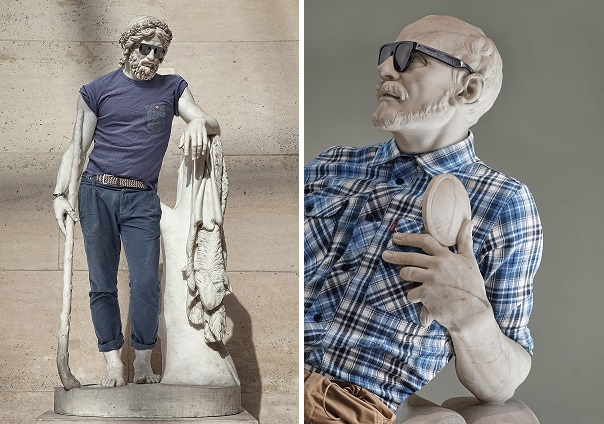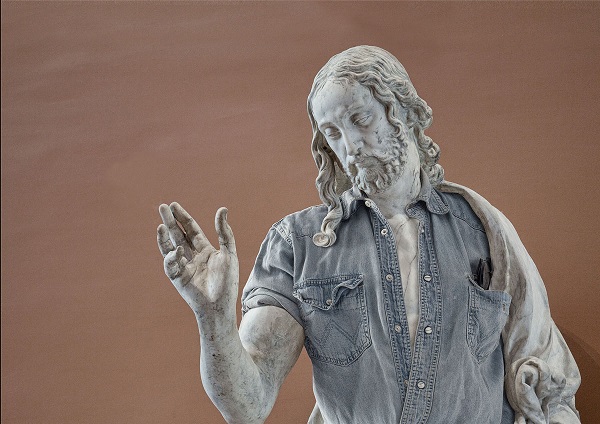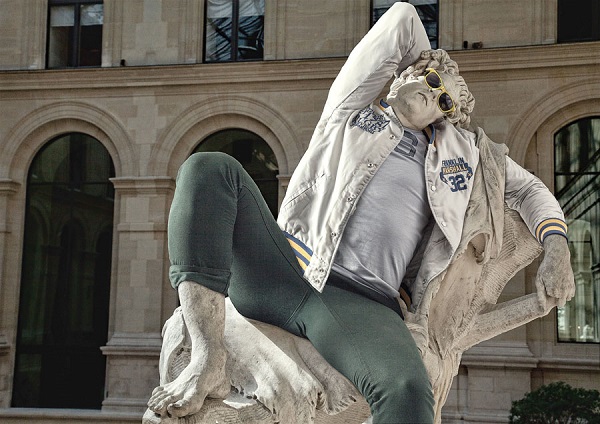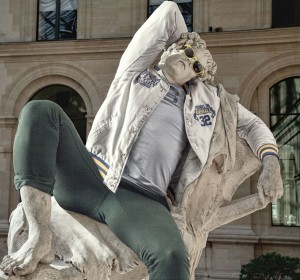Artist of the Week 3/6-3/12: Artist Léo Caillard Explores Cultural and Social Change in the Digital Era
Modern society has and continues to witness the rapid evolution of technology and information systems, creating realities that would defy even the most active imaginations of eras past. How has the digital era transformed humanity and its values, its modes of communication and interaction, and how do we reconcile traditional and futuristic sentiments and virtues? French photographer Léo Caillard addresses these complicated societal questions and others through his expressive photography and digital manipulations.
Raised by two parents in tune with their own musical talents, Caillard gained an appreciation for the arts at a young age. Developing concepts so that each piece reflects the whole, he learned to approach photography like a mathematical equation, being particularly cautious to include every feature essential to the larger picture. Each image possessed a certain element of simplicity, but with careful attention to detail through shadowing and elaborate use of color, the end result would manifest as an eye-popping photograph.
Taking a unique approach to photography, Caillard transcends time periods, offering a diffusion of classical and contemporary concepts and color schemes. The final product is playful imagery hosting deep philosophical questions. One of Caillard’s most recent projects, Street Stone (on which he collaborated with French art director Alexis Persani), pulls vogue sculptures from the Louvre Museum and thrusts them into the imaginative and effervescent world of today’s most popular fashion trends. The contrast of these lifeless stone sculptures reflecting artists’ visual concepts from centuries past together with today’s fashionable wear, creates warm imagery that is relatable to contemporary social groups. In one image, the viewer is presented with a sculpture of the Greek god and culture hero Aristaeus, looking stern and cold; however, after Caillard’s witty alteration, his persona has been transformed into one that can be seen as approachable and hip. Aristaeus can now be seen donning a pair of sunglasses, a t-shirt with rolled sleeves, jeans, and the smallest of accessories to make the look complete. While implementing the new look, Caillard paid specific attention to the details the original sculptor gave to the Greek god’s arms in hope of capturing the creases in his clothes, creating a realistic and active appearance in which Aristaeus, barefooted with a walking stick and animal skin at his side, becomes relatable to modern society. As the viewer, you begin to forget that these are sculptures, and not real humans. This satirical and lighthearted series is distinct from his other works, such as Art Game, in which Caillard has managed to create a museum atmosphere metamorphosed into the chaotic environments of technological interruptions of human thought and observance.
These descriptive and metaphorical photographs attest to what Caillard explains is one of the most detrimental attributes of today’s society — we let technology control humanity and culture, rather than vice versa. In many ways, Caillard’s series give way to speculation about artistic creationism in general. What separates those concepts that live to be iconic throughout the ages versus those that are ephemeral, their popularity to decay with the temperamental trends of their time?
Taking a break from his upcoming pieces, Caillard spoke with GALO Magazine to discuss his work on Street Stone and Art Game in greater depth.

An image of one of the sculptures, dressed in street wear, from the “Street Stone” series, created by artists Léo Caillard and Alexis Persani. Photo Courtesy Of: Léo Caillard.
GALO: Your photographs from the series Street Stone involve numerous, classic sculptures, adorned in modern clothing, completed with a creative use of Photoshop manipulation. The contrast of bright, contemporary garb against the extreme black and white stone of the sculptures resembles black-and-white, hand-painted photographs. How do you utilize lighting and shadows to remake these classical pieces from not just ancient sculptures dressed in modern clothing, but rather into unique, eye-popping pieces? And how did you come to decide upon a color scheme for each image?
Léo Caillard: It’s a long brainstorming process before I begin making any creative manipulations. I went to the Louvre Museum several times to take pictures of the statues. Depending on the day and weather, the light on the sculptures wasn’t the same. Then I began editing all of these pictures in order to keep a few of the statues that had the exact light I wanted.
In [my] studio, I photographed a model wearing different styles of hipster/street wear clothing. I reproduced the exact same light on the model as it was on the statue, and I asked him to pose the same way.
Having colorful street wear on almost black and white statues is very important in this series. A good friend of mine, Raphael Federici, helped me choose the colors and style of clothing for each statue. Raphael is an art director and has a great eye for this kind of association.

An image of one of the sculptures, dressed in street wear, from the “Street Stone” series, created by artists Léo Caillard and Alexis Persani. Photo Courtesy Of: Léo Caillard.
GALO: This is a fun collection. People often view vogue sculptures with dark overtones, but you managed to create a more lighthearted reaction with your imagery. I imagine it was amusing discussing each sculpture’s wardrobe with French art director Alexis Persani, who did the retouching on Street Stone. How did you and Persani come to meet and agree to work with each other and what would you say was your favorite aspect of working on this series with him?
LC: I met Alexis after shooting the pictures. I was thinking about someone who would be able to make the post-production of my idea a reality. Usually, I work with different post-production labs, but Alexis presented me with his photo-manipulation jobs that he made before and I liked the style of his retouch. I then presented him [with] the pictures [from Street Stone] and the concept and he liked it. I decided to let him do the post-production, which he did perfectly.
Alexis is somebody who understands street art and street wear. He knows how this type of clothing has to look like, and I think that helped a lot in making the right decisions during post-production. It’s always hard to decide what to do in front of your computer when something doesn’t work well in the picture. I think he made the right decisions and right manipulations in making everything look as realistic as possible.

An image of one of the sculptures, dressed in street wear, from the “Street Stone” series, created by artists Léo Caillard and Alexis Persani. Photo Courtesy Of: Léo Caillard.
GALO: Did you have any particular interest in vogue sculptures from a specific time period or artist, or had you ever studied them prior to taking on this project?
LC: My work as a photographer is to have a point of view on modern society. In my work, I combine elements from different time periods into the same scene to demonstrate the differences between the past and present world. That’s my way of expression and I use this process as a major part of my photography. I studied art history for many years and I definitely love classic sculptures. I have to say that working with a classic museum background [makes for a] very interesting playground for my creations.
(Article continued on next page)

